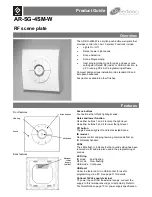
Issue 1.2 May 2020
EVSE Protocol Controller 2.0 (EPC 2.0) | Viridian EV
9
3.7 SEQUENCE OF CHARGING PROCESS
1. INITIALIZATION
After the operating voltage is applied, the module carries out initializations and function tests indicated by two LED pulsing
sequences and then waits for vehicle connection (indicated by pulsing blue LED).
2. CHARGING PROCESS
The module waits for a charging cable or vehicle to be connected (state A) indicated by the blue LED continually pulsing . If an
approved
connecting cable has been connected (see Proximity) and state B is indicated by the vehicle, the module changes the LED to
be steady
-
blue and activates the interlock. A continuing flashing White LED will indicate that the lock is obstructed if the
system has been configured for an interlock.
After interlocking, the charge
-
enable relays are activated if the vehicle is signalling state C. The charging process is activated,
and the LED is changed to steady
-
green (LED indication : A colour combination is used to indicate the firmware version . The
maximum configured charging current is indicated by a series of white pulses ) If state D is indicated (ventilation required)
then charging and interlock are deactivated as the EPC does not provide a fan
-
enable mechanism, and the LED is changed to
steady
-
red.
In a fault condition the charge
-
enable relay and the interlock are deactivated and the LED is changed to continually pulse red.
A slowly pulsing RED LED will require no manual intervention to restart charging from a fault condition, once the fault has
been identified and cleared . A rapidly pulsing RED LED will require manual intervention.
VENTILATION REQUIREMENT
WARNING: SUFFOCATION HAZARD WHEN CHARGING INDOORS
Without ventilation, a danger of suffocation can arise due to gas build
-
up with some battery types when charging indoors. If
the charging process takes place indoors, forced
-
air ventilation should be installed. The Viridian EV EPC 2.0 does not monitor
the functionality of the forced
-
air ventilation systems and so are not compatible.
CONTROL PILOT
The pilot circuit is used for the bi
-
directional exchange of information between the charging station and the vehicle. Via this
signal, the charging station indicates to the vehicle the maximum permitted charging current which the vehicle can call up. The
operational readiness of the charging station is also indicated. Via this signal, the vehicle indicates to the charging station its
current state of charging readiness.
WARNING
Via the pilot signal, the EPC 2.0 module specifies the maximum charging current that can be drawn by the vehicle. This
specified current must be consistent with the line protection configured for the charging device and the rest of the plant
configuration. Failure to observe this notice can result in injury to persons or property damage.
PROXIMITY
With free cable installations the charging device detects the maximum current carrying capacity of the connected charging
cable via the proximity signal. The activated charging output coded in the pilot signal is no greater than the current carrying
capacity of the charging cable.
The EPC 2.0 is designed to operate with available charging current signals of 16A and 32 A ,depending on the current carrying
capacity of the cable that is detected. Note : The advertised current from the EVSE maybe downgraded depending on the
current carrying capacity of the cable detected. . The charging circuit that is activated must be designed with a suitable line
protection for 16A for the installed system .For charging cables that have a current carrying capacity of 32A according to IEC
61851 the system must be designed with a suitable line protection .








































